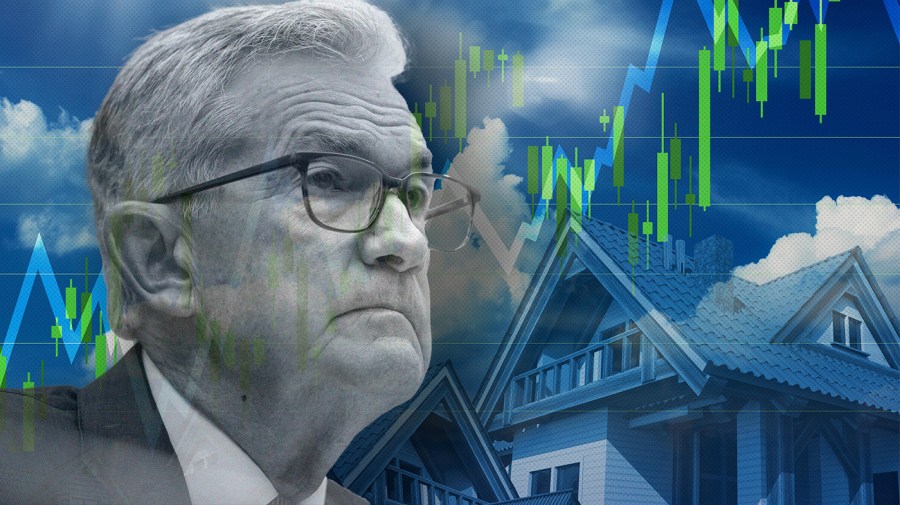Business
Fed’s rate strategy stymied by stubborn housing cost inflation on November 8, 2023 at 11:00 am Business News | The Hill

The Federal Reserve is facing questions about its ability to tame one of the largest drivers of inflation: the cost of housing.
Housing costs, measured as both rental costs within the consumer price index (CPI) and as mortgage rates, are one of the most interest rate-sensitive sectors of the economy, generally getting more expensive as rates go up and cheaper as rates go down.
But with the Fed now expected to keep rates higher for longer, a reprieve in shelter costs, which constitute a major portion of monthly expenditures for U.S. households, could still be a ways away.
Consumers remain hobbled by housing costs
Americans spend about 30 percent of their income on rent, according to research from Moody’s Analytics published over the summer, a record threshold initially reached last year.
Moody’s has described Americans as “rent-burdened,” arguing in April that “rent-to-income levels remain uncomfortably high.” In 2021, 20 million households that pay rent met the 30-percent income threshold and were “cost burdened,” according to the Census Bureau, an increase of about 1 million households since 2019.
“If you look at the consumer price index, the big contributor to high inflation is the shelter, both rents and owner-occupied rents,” Claudia Sahm, founder of Sahm Consulting and a former Federal Reserve economist, told The Hill.
“The increases in shelter costs have absolutely slowed down in the past six to eight months, but they take time to work their way through. … Frankly, we’ve gotten surprised at how long it’s taken and how bumpy it’s been.”
Fed faces pressure to cool down housing market
Inflation has been coming down over the past year as the Fed has been raising rates, falling to an annual rate of 3.7 percent in September from a high of 9.1 percent in June of last year.
But annual housing inflation is still around 7 percent and accounts for the vast majority of all the inflation left in the economy.
The CPI’s shelter index accounted for more than 70 percent of the total increase in all items less food and energy, the Labor Department reported earlier this month.
“The Fed needs to study the housing market at this moment very carefully, because it’s at the point where it really starts to have an effect,” Sahm said. “[Fed Chair Jerome Powell] pointed to the housing market, because it’s clear that activity there is slowing down.”
While one of the fastest Fed tightening cycles on record has driven housing costs higher, an underlying shortage of affordable, multifamily housing has also dogged the housing market.
Realtor.com puts the shortage at between 2.3 and 6.5 million homes.
Can Powell tame property owners?
Tenants-rights activists say that focusing on the financial system or even the physical supply of housing is shortsighted and neglects the fact that landlords and property owners simply have too much power over tenants, allowing them to drive up prices at will.
“Federal housing policy is designed in a way that prioritizes the industry that profits from providing housing, rather than the people who need homes,” argued the Homes Guarantee advocacy group, which wants to see rent control limitations placed on all national housing subsidy programs.
The group also wants to see the Biden administration enact a national tenants bill of rights to protect against profiteering in the housing sector as a matter of public policy.
Powell said Wednesday that effects of housing costs on the economy were becoming “significant.”
“We’re getting reports from housing that the effects of this could be quite significant,” he said, noting that activity in the housing sector has flattened out and remains well below levels of a year ago.
Housing remains in the Fed’s sights
The Fed’s latest anecdotal survey of the U.S. economy is riddled with complaints about the affordability of housing.
“Housing affordability remained extremely low, and rents remained high in the current period. Requests for assistance with housing and utility bills continued to dominate 211 [hotline] requests in New Jersey and Pennsylvania. Roughly one-third of all requests in the two states were related to housing,” the Federal Reserve Bank of Philadelphia reported in the October “Beige Book,” the Fed’s monthly summary of regional economic conditions.
Rental and home ownership affordability as measured in September by the Department of Housing and Urban Development are both near 23-year lows, while month-to-month house prices were near 20-year highs.
“Rising rents and a shortage of affordable housing continued to impact low- and moderate-income households’ ability to secure housing. Moreover, some landlords stopped accepting housing choice vouchers in order to get higher rents in the open market,” the Cleveland Fed observed.
Despite elevated levels, shelter prices have been declining in recent months, with owners’ equivalent rent falling to 7.1 percent in September off a high of 8.1 percent in April.
The shelter component of the CPI also stands at 7.1 percent, off a March peak of 8.2 percent.
But that descent has been touch-and-go and has been a source of surprise for economists.
“It was clear this was coming, but last month forecasters were surprised; it didn’t come down as much as we’d expected. We don’t know exactly how the translation goes between new rents and the CPI,” Sahm said.
“We know the direction of this, but exactly when it happens is not clear, and shelter makes a bigger contribution to the CPI in general, so it’s not like this inflation is just going away.”
Thirty-year fixed-rate mortgages are near their highest levels in 23 years, at 7.86 percent.
“The impact of higher rates continued to be felt across both purchase and refinance markets. Purchase applications decreased to their lowest level since 1995 and refinance applications to the lowest level since January 2023,” Joel Kan, Mortgage Bankers Association vice president, wrote in a note Wednesday.
Economists sound the alarm on bond yields
Soaring bond yields, which are closely correlated with mortgage rates, especially for longer-term maturities, were also a concern for economists watching the outcome of the Fed’s meeting.
“Powell’s focus on persistent conditions, especially regarding the rise in Treasury yields and the near-8% mortgage rate, suggests that the Fed is closely monitoring the broader economic indicators,” Jon Maier, head of investments at financial firm Global X, wrote in an analysis.
Despite the high cost of housing, home ownership rates for moderate earners rose to some of their highest levels ever during the pandemic, boosted by trillions in stimulus sent out by both the Trump and Biden administrations.
In the first quarter, the homeownership rate for Americans earning less than the median family income of $74,580 hit 53.4 percent, a number surpassed in recent decades only during the second and third quarters of 2020, when the government was helicoptering emergency cash onto households during the pandemic, according to Census Bureau data.
Powell stressed Wednesday that Fed bankers had not yet made up their mind about future rate hikes or whether Fed policy was now sufficiently “restrictive.”
“We’re not confident at this time that we’ve reached such a stance. We’re not confident that we haven’t, but we’re not confident that we have,” Powell said.
Business, Administration, News, Policy, Technology, bonds, federal reserve, Federal reserve rate hikes, housing market, Jerome Powell The Federal Reserve is facing questions about its ability to tame one of the largest drivers of inflation: the cost of housing. Housing costs, measured as both rental costs within the consumer price index (CPI) and as mortgage rates, are one of the most interest rate-sensitive sectors of the economy, generally getting more expensive as…
Business
Why 9 Million Americans Have Left

The Growing American Exodus
Nearly 9 million Americans now live outside the United States—a number that rivals the population of several states and signals a profound shift in how people view the American dream. This mass migration isn’t confined to retirees or the wealthy. Thanks to remote work, digital nomad visas, and mounting pressures at home, young professionals, families, and business owners are increasingly joining the ranks of expats.

Rising Costs and Shrinking Wallets
Living in the US has become increasingly expensive. Weekly grocery bills topping $300 are not uncommon, and everyday items like coffee and beef have surged in price over the last year. Rent, utilities, and other essentials also continue to climb, leaving many Americans to cut meals or put off purchases just to make ends meet. In contrast, life in countries like Mexico or Costa Rica often costs just 50–60% of what it does in the US—without sacrificing comfort or quality.
Health Care Concerns Drive Migration
America’s health care system is a major trigger for relocation. Despite the fact that the US spends more per person on health care than any other country, millions struggle to access affordable treatment. Over half of Americans admit to delaying medical care due to cost, with households earning below $40,000 seeing this rate jump to 63%. Many expats point to countries such as Spain or Thailand, where health care is both affordable and accessible, as a major draw.

Seeking Safety Abroad
Public safety issues—especially violent crime and gun-related incidents—have made many Americans feel unsafe, even in their own communities. The 2024 Global Peace Index documents a decline in North America’s safety ratings, while families in major cities often prioritize teaching their children to avoid gun violence over simple street safety. In many overseas destinations, newly arrived American families report a significant improvement in their sense of security and peace of mind.
Tax Burdens and Bureaucracy
US tax laws extend abroad, requiring expats to file annual returns and comply with complicated rules through acts such as FATCA. For some, the burden of global tax compliance is so great that thousands relinquish their US citizenship each year simply to escape the paperwork and scrutiny.
The Digital Nomad Revolution
Remote work has unlocked new pathways for Americans. Over a quarter of all paid workdays in the US are now fully remote, and more than 40 countries offer digital nomad visas for foreign professionals. Many Americans are leveraging this opportunity to maintain their US incomes while cutting costs and upgrading their quality of life abroad.

Conclusion: Redefining the Dream
The mass departure of nearly 9 million Americans reveals deep cracks in what was once considered the land of opportunity. Escalating costs, inaccessible healthcare, safety concerns, and relentless bureaucracy have spurred a global search for better options. For millions, the modern American dream is no longer tied to a white-picket fence, but found in newfound freedom beyond America’s borders.
Business
Will Theaters Crush Streaming in Hollywood’s Next Act?

Hollywood is bracing for a pivotal comeback, and for movie lovers, it’s the kind of shake-up that could redefine the very culture of cinema. With the freshly merged Paramount-Skydance shaking up its strategy, CEO David Ellison’s announcement doesn’t just signal a change—it reignites the passion for moviegoing that built the magic of Hollywood in the first place.

Theatrical Experience Roars Back
Fans and insiders alike have felt the itch for more event movies. For years, streaming promised endless options, but fragmented attention left many longing for communal spectacle. Now, with Paramount-Skydance tripling its film output for the big screen, it’s clear: studio leaders believe there’s no substitute for the lights, the hush before the opening credits, and the collective thrill of reacting to Hollywood’s latest blockbusters. Ellison’s pivot away from streaming exclusives taps deep into what unites cinephiles—the lived experience of cinema as art and event, not just content.
Industry Pulse: From Crisis to Renaissance
On the financial front, the numbers are as electrifying as any plot twist. After years of doubt, the box office is roaring. AMC, the world’s largest theater chain, reports a staggering 26% spike in moviegoer attendance and 36% revenue growth in Q2 2025. That kind of momentum hasn’t been seen since the heyday of summer tentpoles—and it’s not just about more tickets sold. AMC’s strategy—premium screens, with IMAX and Dolby Cinema, curated concessions, and branded collectibles—has turned every new release into an event, driving per-customer profits up nearly 50% compared to pre-pandemic norms.
Blockbusters Lead the Culture
Forget the gloom of endless streaming drops; when films like Top Gun: Maverick, Mission: Impossible, Minecraft, and surprise hits like Weapons and Freakier Friday draw crowds, the industry—and movie fans—sit up and take notice. Movie-themed collectibles and concession innovations, from Barbie’s iconic pink car popcorn holders to anniversary tie-ins, have made each screening a moment worth remembering, blending nostalgia and discovery. The focus: high-impact, shared audience experiences that streaming can’t replicate.
Streaming’s Limits and Studio Strategy
Yes, streaming is still surging, but the tide may be turning. The biggest franchises, and the biggest cultural events, happen when audiences come together for a theatrical release. Paramount-Skydance’s shift signals to rivals that premium storytelling and box office spectacle are again at the center of Hollywood value creation. The result is not just higher profits for exhibitors like AMC, but a rebirth of movie-going as the ultimate destination for fans hungry for connection and cinematic adventure.

Future Forecast: Culture, Community, and Blockbuster Dreams
As PwC and others warn that box office totals may take years to fully catch up, movie lovers and industry leaders alike are betting that exclusive theatrical runs, enhanced viewing experiences, and fan-driven engagement are the ingredients for long-term recovery—and a new golden age. The Paramount-Skydance play is more than a business move; it’s a rallying cry for the art of the theatrical event. Expect more big bets, more surprises, and—finally—a long-overdue renaissance for the silver screen.
For those who believe in the power of cinema, it’s a thrilling second act—and the best seat in the house might be front and center once again.
Business
Why Are Influencers Getting $7K to Post About Israel?

Influencers are being paid as much as $7,000 per post by the Israeli government as part of an expansive and sophisticated digital propaganda campaign. This effort is designed to influence global public opinion—especially among younger social media users—about Israel’s actions in Gaza and to counter critical narratives about the ongoing humanitarian situation.

How Much Is Being Spent?
Recent reports confirm that Israel has dedicated more than $40 million this year to social media and digital influence campaigns, targeting popular platforms such as TikTok, YouTube, and Instagram. In addition to direct influencer payments, Israel is investing tens of millions more in paid ads, search engine placements, and contracts with major tech companies like Google and Meta to push pro-Israel content and challenge critical coverage of issues like the famine in Gaza.
What’s the Strategy?
- Influencer Contracts: Influencers are recruited—often with all-expenses-paid trips to Israel, highly managed experiences, and direct payments—to post content that improves Israel’s image.
- Ad Campaigns: State-backed ad buys show lively Gaza markets and restaurants to counter global reports of famine and humanitarian crisis.
- Narrative Management: These posts and ads often avoid overt propaganda. Instead, they use personal stories, emotional appeals, and “behind the scenes” glimpses intended to humanize Israel’s side of the conflict and create doubt about reports by the UN and humanitarian agencies.
- Amplification: Paid content is strategically promoted so it dominates news feeds and is picked up by news aggregators, Wikipedia editors, and even AI systems that rely on “trusted” digital sources.
Why Is This Happening Now?
The humanitarian situation in Gaza has generated increasing international criticism, especially after the UN classified parts of Gaza as experiencing famine. In this environment, digital public relations has become a primary front in Israel’s efforts to defend its policies and limit diplomatic fallout. By investing in social media influencers, Israel is adapting old-school propaganda strategies (“Hasbara”) to the era of algorithms and youth-driven content.
Why Does It Matter?
This campaign represents a major blurring of the lines between paid promotion, journalism, and activism. When governments pay high-profile influencers to shape social media narratives, it becomes harder for audiences—especially young people—to distinguish between authentic perspectives and sponsored messaging.

In short: Influencers are getting $7,000 per post because Israel is prioritizing social media as a battleground for public opinion, investing millions in shaping what global audiences see, hear, and believe about Gaza and the conflict.

 Business4 weeks ago
Business4 weeks agoDisney Loses $3.87 Billion as Subscription Cancellations Surge After Kimmel Suspension

 Entertainment4 weeks ago
Entertainment4 weeks agoWhat the Deletion Frenzy Reveals in the David and Celeste Tragedy

 Entertainment4 weeks ago
Entertainment4 weeks agoExecutive Producer Debut: How Celia Carver Created Festival Hit ‘Afterparty’

 Health4 weeks ago
Health4 weeks agoRussia Claims 100% Success With New mRNA Cancer Vaccine

 News4 weeks ago
News4 weeks agoBody of Missing Teen Found in Tesla Linked to Musician D4vd

 Business2 weeks ago
Business2 weeks agoWhy Are Influencers Getting $7K to Post About Israel?

 Health4 weeks ago
Health4 weeks agoWhy Did Gen Z QUIT Drinking Alcohol?

 Business4 weeks ago
Business4 weeks agoYouTube’s New Sponsorship Update Could Make Creators Richer




























